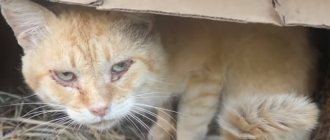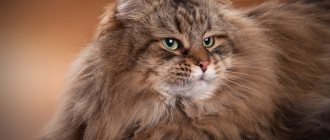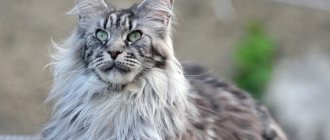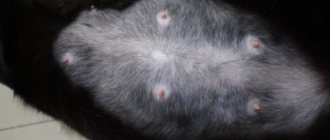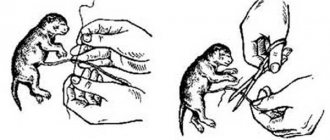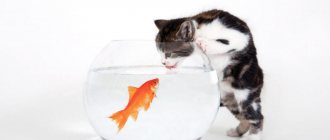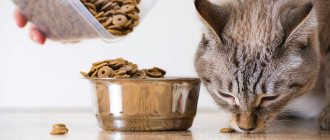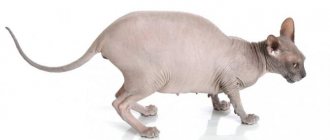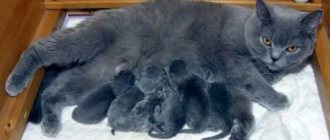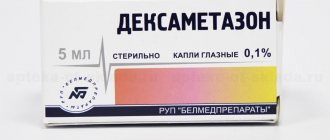4182Administration
The pads on a cat's paws are always present and do not raise questions among owners, as they are perceived as a palm. Most often, pad 7 is of interest, which is located as if on the wrist, if we consider the pet’s paw as a human hand. Such a pad does not come into contact with the ground when walking, but is indispensable during jumps and sharp turns during active running. This unusual pad, separated from the toes, is the main protection of the joint located underneath it from injury, even if the cat jumps from a considerable height.
How many toes does a cat have on its paws?
How many toes does a cat have on its hind paws?
Most will answer: “five, like everyone else!” However, they will be surprised when they check how many there actually are. Cats, like all mammals for the most part, during their development received five fingers on each limb. Evolution considered this number optimal for solving many problems in life.
However, then she decided that some fingers could still be abandoned, since they were not used. For example, in a horse it is possible to distinguish the pulses on the limbs, although their number and appearance will clearly differ from the general average.
But there's a problem with the back paw. It seems to be the same set: phalanges of the fingers, metatarsus and tarsus (everything is the same, in human terms), but there are only 4 of these sets. Yes, a cat has four toes on its hind paws. This can be explained by the fact that during a hunt, a cat can run, and in order to avoid clinging to branches, grass and injuring it with its fifth finger, evolution “took away” this fifth finger.
Dogs, compared to cats, have 5 toes on their hind paws, and this causes them many problems, especially hunting dogs. And all for the same reasons. In pursuit of the beast, they often break these fingers. Therefore, many owners remove these extra fingers from their pets during puppyhood.
And still there are cases when there can be five, seven, or even more fingers. This disease, which can be hereditary in nature or result from a disorder of intrauterine development, is called subdydacty.
In humans and animals, it can appear on one or both hands. Usually the extra finger is a small piece of soft tissue that can be removed. Sometimes it's just bone without joints; Very rarely the extra finger is a full one. An extra finger most often forms on the side of the little finger, less often on the side of the thumb, and very rarely between the middle fingers. Usually an extra finger is an abnormal branching of a normal finger, rarely occurring on the wrist like a normal finger.
Source
What is polydactyly
The standards for the vast majority of domestic breeds call the general norm for a cat to have eighteen toes. But there are exceptions to the usual rules - cats with many toes. Denoting a fairly common genetic mutation, the word “polydactylism” consists of two Greek words: “poly” is translated as “many”, and “dactylos” is translated as “fingers”; This phenomenon is also called hyperdactyly. With polydactyly, one paw can have up to seven toes, and sometimes even more.
Polydactyly in cats is a harmless but very unusual mutation.
Most often, the mutation appears on the front legs, somewhat less often - on all four limbs, and most rarely - exclusively on the back legs of the cat.
Polydactyly is inherent in almost all animals and even humans, but in the cat family this strange phenomenon occurs most often. If one of the parents is polydactyl, then the probability of giving birth to “polydactyl” kittens reaches sixty percent.
Postaxial polydactyly makes a cat's paws stable in the snow
There are two known varieties of feline polydactyly, which in the slang of felinologists are called “mittens” and “snowmobiles”. Postaxial polydactyly - when additional fingers are aligned with the main ones. This helps the animal easily move through deep snow without falling into it - that’s why these cat paws are called snowmobiles. And with preaxial polydactyly, the extra fingers grow as if separately from the rest. At the same time, the cat's paw really resembles a funny mitten.
Preaxial polydactyly - these paws really look like mittens
There are also examples of “reverse” mutation - hypodactyly, which, unfortunately, is not as harmless as polydactyly. Kittens that at birth had fewer than the standard eighteen fingers rarely survive to adulthood: they usually have pathologies or severe underdevelopment of the liver. The gene mutation that causes hypodactyly activates the so-called “junk” genes, which provoke the development of dangerous pathologies in the cat.
Video: polydact - a cat in mittens
Extra fingers - where and why?
Multi-toed cats have been known for a very long time - they live with humans for as long as our domesticated feline community has existed. According to the scientific definition of geneticists, manifestations of polydactylism are inherited as an autosomal dominant trait of the Pd gene with incomplete penetrance.
Does this cause discomfort to the cat? Judging by appearance alone, one would think that polydactic cats must have a very difficult time moving around. In fact, this is completely wrong. Since the anomaly is congenital, the “special” kitten perceives it as a completely natural state of affairs and does not spend any effort to adapt. True, breeders note that such babies take a little longer to learn to walk than their usual 18-toed littermates.
Multi-toed kittens start walking a little later than their “standard” littermates.
The paws of such animals are much more stable when walking on various difficult surfaces, and when hunting, a couple of additional claws are never superfluous. According to an old legend, in difficult times of hunger, multi-toed Maine Coons even learned to catch fish in order to give it to their owners for food.
Video: the more fingers, the more convenient it is to play
Record holders for the number of fingers
It is difficult to name a clear record holder for polydactylism. Recently, the popularity of polydact cats has been growing rapidly throughout the world, and there are quite a few examples of individuals with seven toes on each paw. According to some reports, there was a Mickey Mouse cat whose total number of fingers reached 32 - it was reported back in 1974, but there is no official confirmation of this phenomenon.
Sometimes polydactyly is confused with another congenital mutation - polymelia, in which additional fingers appear due to an extra limb fused to the main one. Most likely, the cat Mickey Mouse had just such a pathology.
There are 8 toes on the paw; if everyone else has the same amount, then this cat is the undisputed record holder
Polydactyly, to one degree or another, can occur in both purebred and outbred cats. But this hereditary mutation is most often observed in breeds of North American origin - especially the multi-toed Maine Coons. It has been noticed that animals with polydactyly have more powerful bones - their chest is wider and their front legs are thicker than those of ordinary littermates.
Video: polydactyly or polymelia?
Multi-toed cat breeds
The American polydactyl cat is an indigenous North American breed, about the origin of which scientists do not have a consensus - only versions. Only the historical homeland of the American polydactyl cat is known for certain - the state of Massachusetts. Polydactyl cats, semi-wild and tame, have lived here since time immemorial and were famous for their success in catching mice.
Attempts to form a breed based on indigenous individuals began at the end of the nineteenth century, but were scattered and unsystematic. As a result, the American polydactyl cat has remained unrecognized by authoritative felinological organizations to this day.
The American Polydactyl Cat is an unrecognized breed of aboriginal origin.
Some breeders claim that forty percent of Maine Coon kittens in their catteries are born multi-toed. For a long time, such babies were discarded or sterilized, not allowed for breeding. But the breed's potential takes its toll - polydactyly is embedded in the genetics of Maine Coons.
Initially, this feature helped the native North American breed survive the harsh winter: it is easy, like on skis, to move through snowdrifts and effectively obtain food for itself. In the summer, polydactic giants successfully used their extra fingers to climb trees and catch fish.
Multi-toed paws help Maine Coons not to fall into deep snow
Recently, some mustelid nurseries have begun to purposefully breed polydacts. This bold undertaking was initiated by reputable breeders from Holland and Belgium - they are striving to recognize the multi-toed Maine Coon as a new breed, at least in experimental status at first. And recently, the American Maine Coon Breeders Association (MCBFA) developed a standard for a new breed line; Registration of polydact cats is carried out by such US felinological organizations as CFA and TICA.
Video: multi-toed Maine Coon from Omsk
The Pixie Bob (or Short Tail Elf) is the only internationally recognized breed that is officially fully polydactyly according to its standard. In the section of the breed standard that describes the pixie-bob’s paws, it literally says: “Polydactyly is allowed, with a maximum of seven toes.”
The Pixie Bob is the only breed whose standard welcomes polydactyly.
The extra toes perfectly solve the problem of evenly distributing the load on the paws, because the body of the short-tailed elf is extremely massive and muscular. Thanks to them, even the largest cats can run, jump and play with amazing ease.
Multi-toed representatives of this breed are valued several times higher than ordinary ones. Of course, there is no direct relationship between the number of toes on the paws and the price, but purebred, polydactic kittens that meet the standard can cost ten thousand dollars or even more. Multi-toed pixie bobs are also highly appreciated by experts at exhibitions.
Video: short-tailed elf with six fingers
Responsible breeding work is required to eliminate from breeding individuals suffering from radial hypoplasia, a rare anomaly that can accompany polydactyly. With this genetic disorder, the cat's paws are weakened, and the extra toes are fused, resulting in the animal being disabled.
Interesting Facts
Immediately after the discovery of America, the multi-toed cats discovered there had their eyes set on... by sailors. Thanks to them, most likely, polydacts came to Europe. Sailors believed that such cats brought good luck and were especially valued for their paws that were stable when rocking and their hunting talents - extra fingers and claws were very useful in the fight against ship rats and mice. The term “ship cats” originates from here.
A multi-toed cat on a ship brings good luck
In Medieval Europe, polydacty cats were subjected to brutal extermination during the troubled times of the “witch hunt.” Extra toes on a cat's paws were perceived by the Inquisition as a clear sign of the devil.
One of the first cats to live in the White House was Slippers, the favorite of US President Roosevelt. Slippers, who belonged to the American polydactyl breed, was distinguished by his intelligence and regal demeanor and often graced various official events with his presence. Interestingly, slippers translates from English as “slippers” - a great name for a multi-toed cat!
President Roosevelt and his beloved cat Slumpers - they have something in common, don't they?
Polydacts are sometimes called "Hemingway's cats." It turns out that the great writer Ernest Hemingway loved cats - about fifty of them lived on the territory of his estate in Key West. And the clear favorite of “old Ham” was the cat Snowball, who had six toes on each of her front paws. Now in Key West, where the writer’s house-museum is located, there are at least sixty cats and cats on board, most of them polydactics; these are the descendants of the famous Snowball.
Ernest Hemingway loved cats
Photo gallery: multi-toed cats and kittens
The Canadian polydact cat Plohish got his name for his special ingenuity in pranks.
The famous cat Tiger is a representative of the American Polydactyl breed, he has 27 fingers
Maine Coon Polydact Samba is the most famous cat of Samara
A California woman discovered a litter of multi-toed kittens in her garage.
A kitten named Wallace was dropped off at a Portland veterinary clinic.
Fingers in cats: their functions and number
join the discussion
Share with your friends
Cats have lived side by side with people since ancient times. Despite their willful and independent nature, these amazing creations of nature are universal favorites of cat lovers of all ages. It has been observed that people who have cats in their homes have a significantly reduced risk of heart attack and stroke. They have no equal in physical capabilities.
They are capable of performing masterful jumps, balancing on a narrow strip with a minimal support area, moving silently, climbing tall trees, reacting with lightning speed to changing situations, and much more. Not the least role in such abilities belongs to the structure of their limbs and fingers.
Interesting Facts
- do not see kittens with fewer toes , since they necessarily have another severe pathology in the development of internal organs, leading to death soon after birth.
- Zoological scientists are breeding a breed of cats with polydactyly - Maine Coon, they have 6 toes on their hind paws.
- When walking or running, an animal rests on only 4 fingers , no matter how many there are.
Those with extra toes and claws live well in the wild; this quality helps stray cats not only to get food, but also to protect themselves from other relatives or uninvited guests
Functions
Cats walk on their toes like ballerinas. It is the fingers that play the main role in the movement of cats. They do not step on their entire foot, but walk “on tiptoes.” The mobility and flexibility of cat fingers allows animals to move quickly and silently, sneak up on prey unnoticed, make unexpected maneuvers and rapid jumps, which is very important for predators. The fingers are able to move separately from one another and rotate in the desired direction, which allows the cat to stay on high-risk surfaces: slippery, almost vertical, vibrating, loose, uneven.
When jumping from great heights, the toes serve as shock absorbers; elastic pads make the landing softer and safer, protecting the paws from injury. Most likely, everyone has more than once observed how cats “wash themselves” with the help of their front paws, and superstitious people associate all sorts of signs with this procedure.
In fact, cats do this solely for hygienic purposes, since these animals are clean by nature. These predators must secretly approach their prey and not give themselves away by anything - neither the sound of footsteps, nor body odor. For centuries, nature has noticed and consolidated everything that is valuable and useful for the survival of any existing species.
Sweating occurs through the paws. There are sweat glands on the fingertips. Cats sweat not only in hot weather, but also in stressful situations. The pads provide thermoregulation and prevent overheating of the body. Cats use their front fingers and claws to catch and hold prey, while their hind paws strike. Among felines, just like among people, there are “right-handed” and “left-handed,” with cats preferring the left side and cats preferring the right side. On the “priority” limb, animals have more developed fingers.
How to care for cat paws
All cats instinctively take great care of their paws, and the owners’ task is to help them do this as much as possible. Even a very minor injury - a scuff, crack or scratch on the pads of the fingers can greatly unsettle your pet: he will become irritable or, conversely, depressed, and lose his appetite. In addition, wounds in this area are extremely painful, and sensitive cats suffer greatly from them.
The causes of injury to the pads of the paws and fingers can be very different:
- physical - cuts from sharp objects at home or while walking;
- thermal - cats often get burns by jumping, for example, on a hot stove, and in extreme cold, frostbite occurs on their fingers;
- chemical - if an animal walks in the snow in winter, then the substances that are sprinkled on it may cause a chemical burn on the foot;
- improper nutrition - unbalanced, poor-quality feeding leads to cracking of the skin on the pads and the appearance of weeping ulcers.
Even a minor finger injury can have serious consequences.
Some skin and internal diseases or severe stress can also negatively affect the condition of cat fingers. Such problems require diagnosis and comprehensive treatment under the supervision of a veterinarian.
To eliminate the problem, you need to identify its cause in a timely manner, and for this you should periodically carefully examine your pet’s paws. And at the slightest violation of the skin on the pads and fingers, immediately wash and heal the wounds. It is also very important to constantly monitor the condition of the claws - make sure that they do not grow too long, do not split or get injured.
Trim your cat's claws promptly
An excessively overgrown claw or neglected injuries are common causes of inflammatory processes, which in some cases can even lead to amputation of a finger.
If your cat does not wear down her claws naturally, she will need to have her nails done by herself or by a veterinarian as they grow back. To prevent your pet from damaging upholstered furniture and wallpaper with its claws, just buy him a good scratching post or make one yourself from scrap materials - it’s not difficult at all.
Buy your cat a good scratching post
In polydactic cats, the claws on the “extra” toes grow at a faster rate than on regular toes. This must be taken into account in order to adjust their length in a timely manner.
Video: DIY scratching post - it's easy
Counting fingers and claws
As a standard, International organizations of felinologists consider it normal for ordinary cats to have 18 toes. The front legs have 5 toes; when walking, 4 step on the ground, located in the same row, and the fifth is located above the rest, does not participate in walking, but helps animals climb vertically and move along an inclined surface. Cats have 4 toes on their hind legs.
Among cats, there are frequent cases of the birth of offspring with a non-standard number of fingers. Most often, deviations from the norm occur on the front legs, but they can also occur on the hind legs. Instead of 5 on the front paws, a kitten may have 6 or more toes.
The Canadian cat Jake, who had 28 toes, 7 on each foot, is listed in the Guinness Book of Records. There is a known case of a cat being born with 32 toes. Individuals with “extra” fingers are called polydacts, and the phenomenon itself is called polydactyly (“poly” - many, “dactylos” - finger).
The importance of maintaining healthy nails
It is important to maintain your pet’s claws in good condition, as a lot depends on it. If you don’t want your pet to spoil carpets and furniture, be sure to purchase a scratching post. This simple device can save you a lot of nerves.
In the simplest case, you can make a homemade “sharpener” by taking a small piece of wood and wrapping it tightly with rope. Why are claws so important for an animal’s health? If they grow too large, the pet will experience severe pain. Because of this, the cat will become less active, lose its appetite, and become exhausted.
Possible anomalies
Gene mutations are characteristic of all multicellular organisms, and they are also found among cats. An abnormal number of toes can occur in both male and female cats. This genetic disorder is inherited. If at least one of the parents is polydactic, then the probability of having multi-fingered offspring is very high. “Extra” toes can be on one kitten’s paw, on several, or on all four at once.
Even if there is only one “extra” toe on one leg, then this is definitely nothing more than a manifestation of the polydactyly gene. This structural feature is not considered a genetic deformity, does not affect health, and does not bring any discomfort to the animals. The only negative is that such animals cannot participate in exhibitions due to non-compliance with exhibition standards, which no one will regret if the cat is healthy, energetic and beautiful. When examining newborn kittens and discovering a “special” kitten, it is recommended to contact a felinologist and find out the prognosis for the development of the animal with the identified anomaly.
Positive and negative properties of polydactyly
Polydactyly has many advantages:
- A cat with extra toes can be easily held on any surface;
- Can move quickly in the snow or swim;
- Uses door handles freely for their intended purpose;
- It walks completely silently and can sneak up very close to its prey;
- With great dexterity, he catches fish in a stream or home aquarium.
However, in some cases, a completely different gene may be responsible for the development of polydactylism - the one that causes deformed limbs in cats, bent joints, and ingrown claws. Such animals require treatment at a veterinary clinic.
The most dangerous deviation is a thumb with three phalanges. Animals with this defect may give birth to underdeveloped kittens. Individuals with three-phalanx fingers are subject to mandatory
sterilization.
Usually the gene that is responsible for the presence of polydactyly is inherited. If at least one of the parents has more fingers than normal, some of the offspring will necessarily be multi-fingered. But since this is a recessive gene, the remaining kittens will have completely normal legs.
Features of paws
The specific structure of the paws gives special grace and elegance to the movements of all representatives of the cat family. The paw pads have many nerve endings and receptors, which provide high sensitivity. Felines are able to detect the finest vibrations, which helps these versatile hunters detect prey at the slightest rustle. The cat will feel the upcoming earthquake much earlier than the owner.
The cat's toes have an elastic pad without a wool covering, and each pad contains a sharp sickle-shaped claw. With the help of tendons and muscles, cats retract their claws into a kind of “case” made of leather, reminiscent of a sheath. Retracted claws do not interfere with cats' walking at all. But if you need to climb vertically, defend yourself from enemies, or grab prey, the animals instantly spread their fingers and “unsheath” their formidable weapons - they release their sharp claws.
Important! All cats are pacers: when walking, they move both right legs at the same time, then both left legs.
Ambling gives the cat additional maneuverability and stability, helps to quickly gain speed and change the direction of running, practically without slowing down.
Features of walking of cats and cats
Cats are characterized by digital walking. This is probably why their gait is so silent. In addition, they place their hind paws in the place where their front paws stepped. This allows them to reduce the number of visible marks.
But these animals have another interesting feature. Cats are pacers.
Ambling is the simultaneous forward movement of the front and rear legs on one side, that is, left-left, right-right.
The peculiarity of this gait greatly increases the speed of movement and provides greater stability during sudden changes of direction.
The cat walks, moving its paws forward first on one side, then on the other.

